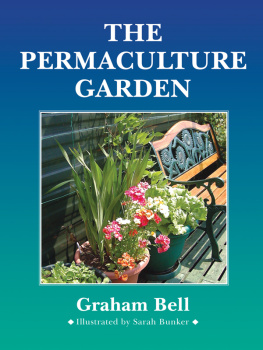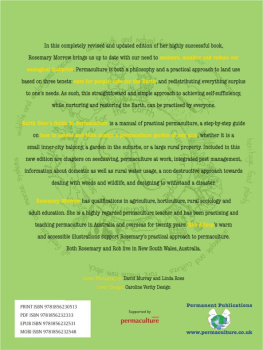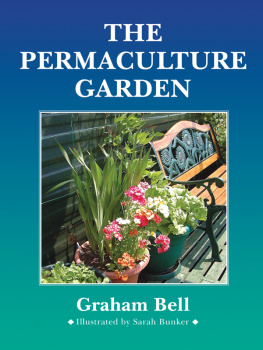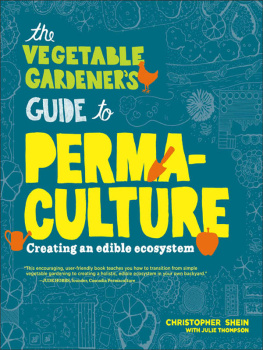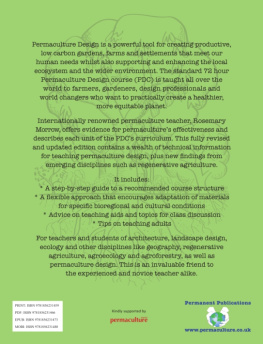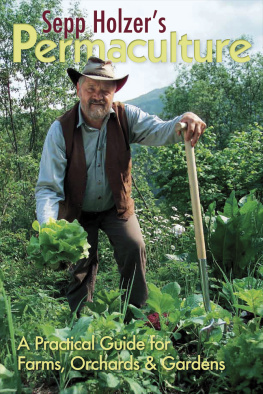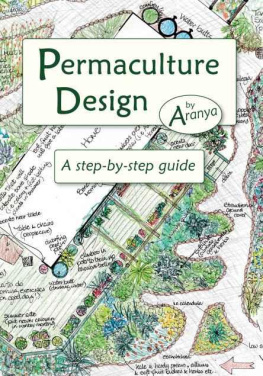
THE
PERMACULTURE
WAY
Practical steps to create a
self-sustaining world
Graham Bell
Illustrated by Brick
Foreword by Bill Mollison
Preface by David Bellany
CHELSEA GREEN PUBLISHING COMPANY
White River Junction, Vermont
A Permanent Publications Book
Published by:
Permanent Publications
Hyden House Ltd.
The Sustainability Centre
East Meon
Hampshire GU32 1HR
UK
Tel: (01730)823 311
Fax: (01730) 823 322
Email: enquiries@permaculture.co.uk
Web: www.permaculture.co.uk
Published in the United States in 2005
by Chelsea Green Publishing Company
www.chelseagreen.com
Published in 2004
by Permanent Publications, UK
First Published 1992
by Thorsons an imprint of Harper Collins
1992 Graham Bell
Graham Bell asserts the moral right to
be indentified as the author of this work
Illustrations 1992 Brick
Cover photographs Photos.com and Nova
British Library Cataloguing-in-Publication Data
A catalogue record for this book is available from the British Library
eBook ISBN: 978-1-60358-129-5
All rights reserved. Apart from any fair dealing for the purpose of study, research, criticism or review, as permitted under the Copyright Act, no part of this publication may be reproduced, stored in a retrieval system, rebound or transmitted in any form or by any means, electronic, mechanical, photocopying, recording or otherwise, without the prior written permission of Graham Bell, Hyden House Limited or Chelsea Green Publishing Company.
For my father
Jim Bell
and for all fathers
that we may give with compassion,
and receive with joy.
The contents of this book and the word Permaculture are copyright. The word permaculture can be used by anyone adhering to the principles and ethics expressed herein. The only restriction on use is that of teaching; only graduates of a Permaculture Institute can teach 'Permaculture', and they adhere to agreed-on curricula developed by the College of Graduates of the Institutes of Permaculture.
I would like to thank my partner Nancy Woodhead for her creativity and support during the production of this book. I am grateful to Andy Langford for his hard work in establishing Permaculture in temperate Britain over many years, and for the large number of ideas he has cheerfully given myself and others.
I am grateful to Andy and Nancy for reading the script and also to others who did so, notably Diana and Jay Wood-head, and Ian Lillington whose prompt and detailed comments were much appreciated. I thank my colleagues Kate Cox, Andy Foreman, and Caroline Leckenby who also read the manuscript, but more importantly kept daily business turning over whilst I was absent from my desk, idly writing this book.
The following people, knowingly or unknowingly, provided help, ideas and information on specific points:
Eoin Cox (landscape), Chris Dixon (wilderness), Ian Flindall (energy), Ken Hennessy (species), Verity Langford (work), David Leigh (water), Jim McGurn (transport and community), Stephen Nutt (maps), Lon J Rombough (US varieties and references), Dorothy Shipp (midwifery), Bernard Quinn (geotextiles).
Permaculture in the UK has benefited greatly from three senior growers whose gentle momentum in the face of official indifference is exemplary: Robert Hart, Arthur Hollins and Bruce Marshall, please take a well deserved round of applause. I am conscious that there are many more creative and visionary people throughout the world who shine in their achievements in greening the planet, and that you may be one of them. I look forward to this minority of souls becoming the majority, and hope that this book makes some modest contribution to that change.
Many more people who are unnamed have contributed to my thinking, and I particularly thank all those who write for Permaculture News for their free input to expanding our understanding of the planet. The authors mentioned in the booklist have all added dimensions to my vision of a sane future.
The final manuscript is my responsibility, but would not have been possible without the enthusiasm of all these people, and the support of my household. I also thank John Button for his tireless commitment to advancing green thinking and John Clark for his drawings, which help show that planet-repair can be fun.
by Bill Mollison
This major effort by Graham Bell of Scottish Permaculture may be added to the slim library of those who teach or practise integrated design. The book deals with cool climate, and more specifically with plants and animals for the British Isles and Europe, but the principles and philosophy hold good anywhere on Earth.
I suspect that this book is the precursor to others which will arise to elaborate specific techniques for specific places - we need similar books for tropics and arid lands, and even for specific methods of production. Permaculture, as a system of design for people in nature, has come a long way since 1974 when it was first proposed by myself and David Holmgren.
There are now more than 54 international teaching centres and over 80 teachers at work; student numbers and projects (some 6000 students by the close of 1991) are expanding exponentially, and will need to do so if we are to offset the damage done to soils, forests, air quality, water and basic nutrition by an uncontrolled materialism. This is obvious to all of us as unethical monetary and monopoly supply systems under the guise of 'free market'. Our only real freedom is to choose those areas where we can act responsibly in relation to conserving and regenerating the earth's resources - and this is mainly achieved in our homes, but also in our work.
Many local regions are now organising to increase self-reliance. In a real sense the current recession differs profoundly from the previous recessions of overproduction (1928-35) or financial mismanagement (1890s). It is a recession of wealth, of natural resources, caused by overuse and wastes, and may well continue for the foreseeable future; natural assets are our only real wealth, and may have been devastated for that ephemeral and unreal substitute -money.
As the numbers grow of those who, like Graham Bell, consolidate their knowledge in real projects, so wasteful systems will change, and we can only create widespread change by cooperating to create our own future. Work-netting, not networking is the way to do this. Each of us need do very little to create a sustainable future; it is only the sum of all our small efforts that changes society and land-cure ethics. Graham outlines the way forward. Good luck to all of us.
Bill Mollison
by David Bellamy
I have four books in my library which form the cornerstones of my hope for the future: Marcus Porcius Cato's Treatise on Agriculture, (circa 160 AD); Robert Sharrock's History of the Propagation and Improvement of Vegetables by the Concurrence of Art and Nature (1660); Hans Jenny's The Soil Resource (1980), and Bill Mollison's Permaculture (1988). I can now add this book to the collection, for it is of great importance. This is a spring-board text, which relaunches the wisdom of almost twenty centuries into the arena where it is most needed and from which it can be most effective - the rich countries of the temperate world.
With more than a third of the world agricultural and pastoral lands already threatened by erosion and desertification, with an estimated 100 000 people dying every day of conditions relating to malnutrition and environmental pollution, and with the human population exploding through the 6


